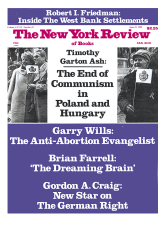In response to:
Can the US Remain Number One? from the March 16, 1989 issue
To the Editors:
In “Can the US Remain Number One?” Paul Kennedy refers to my arguments as to why his analogies between the United States today and Britain at the beginning of the century are misleading. He replies that no two great powers in history were ever “like.”
Of course not. The relevant questions are in what way they are alike and what lessons one draws from the analogy. My arguments showed that his portrait of continuous rapid decline and his theory of imperial overstretch do not fit the facts of the modern American case. Thus it is gratifying to learn that now the central point of his analogy is merely “that the number one power was now operating in a much more challenging and competitive world.” Who could disagree? At that level, the analogy is appropriate, but tells us less than did his previous efforts. It is a tribute to a fine historian that he gives up political science when the facts don’t fit.
Joseph S. Nye, Jr.
Cambridge, Massachusetts
Paul Kennedy replies:
Since I wrote my review with very positive feelings toward Professor Hendrickson’s book—indeed, I asked the editor of The New York Review if I could include The Future of American Strategy in my article—I don’t now want to react negatively to his “clarification.” I do recognize that on pp. 38-39 he offers a discourse on the need to return to Eisenhower’s “great equation” of achieving a balance between the nation’s military security and its economic security. My point simply was that, as compared with such a brief acknowledgment toward the nonmilitary dimensions of American national security, Mr. Hendrickson seems far more at home in his detailed discussions of “Strategic Nuclear Policy” (pp. 117–144) and “General Purpose Forces” (pp. 145–176). And so, indeed, is that entire array of American strategists, from Brodie and Kahn to Kissinger, Luttwak, and the rest, who all too often have equated weapons-systems policy and military posture with “Grand Strategy.” Professor Hendrickson’s frequent reference to Lippmann distinguishes him from those celebrities. But in a work squarely basing itself upon Lippmann’s dialogue over “commitments” versus “resources,” it is fair (or so it seemed to this reviewer) to demand that equal space be given to the issue of nurturing “resources” as well as to that of redefining or even reducing overseas deployments and “commitments.”
As for Professor Hendrickson’s second paragraph, I have to reply that there is no way that I can “declare victory in the war among the intellectuals over American decline….” Not only would that be presumptuous—and immediately contested; but it would distort what the original message of The Rise and Fall of the Great Powers (at least pertaining to the United States today) was all about: that it is in a period of relative decline compared with 1945, which is part natural, part self-induced; that if some worrying trends continue, it “runs the risk of… imperial overstretch”; that the Soviet Union’s plight is much worse; and that American leaders need to readjust to a fastchanging global environment. Much of this remains debatable, as can be confirmed here by Professor Nye’s letter. Even among scholars whose positions are not very far apart (which would, I believe, describe myself and Professor Nye), there are still disagreements over the statistical evidence concerning the extent of America’s relative decline. And even if we had reliable long-run statistics freed of distorting elements (such as our recent habit of measuring GNP size in terms of power purchasing parities rather than current exchange rates), there would still exist individuals who would criticize Rise and Fall on other grounds.
Professor Hendrickson’s final point is fair enough. It is true that I offered “very little in the way of concrete suggestions and hard choices” in Rise and Fall; if I had done so, it would have been a very different sort of book. In the near future, I hope to offer a further contribution to the debate about how to interpret the massive transformations that are bearing down upon the globe we inhabit. But whether it will be a handbook for day-to-day policy makers, I very much doubt. Historians are not “policy animals,” even when they venture to comment upon current affairs. All that we can hope to do is to encourage a broad historical consciousness in the minds of decision makers almost overwhelmed by immediate and short-term issues.
This Issue
June 15, 1989



